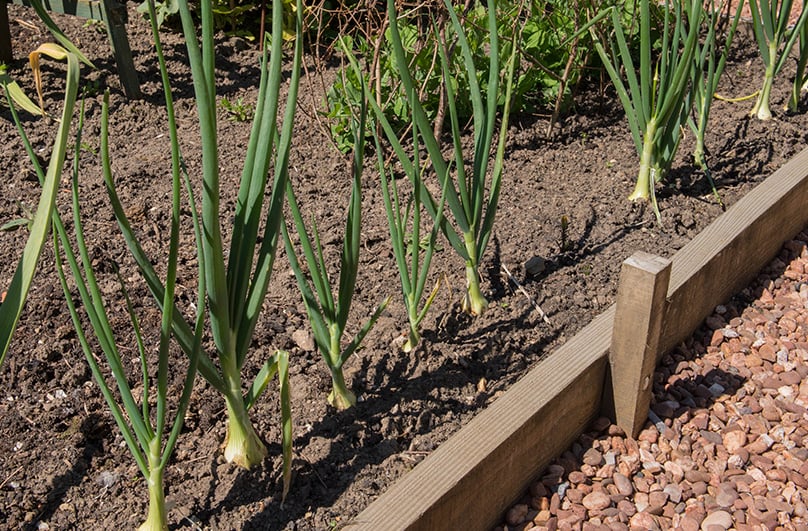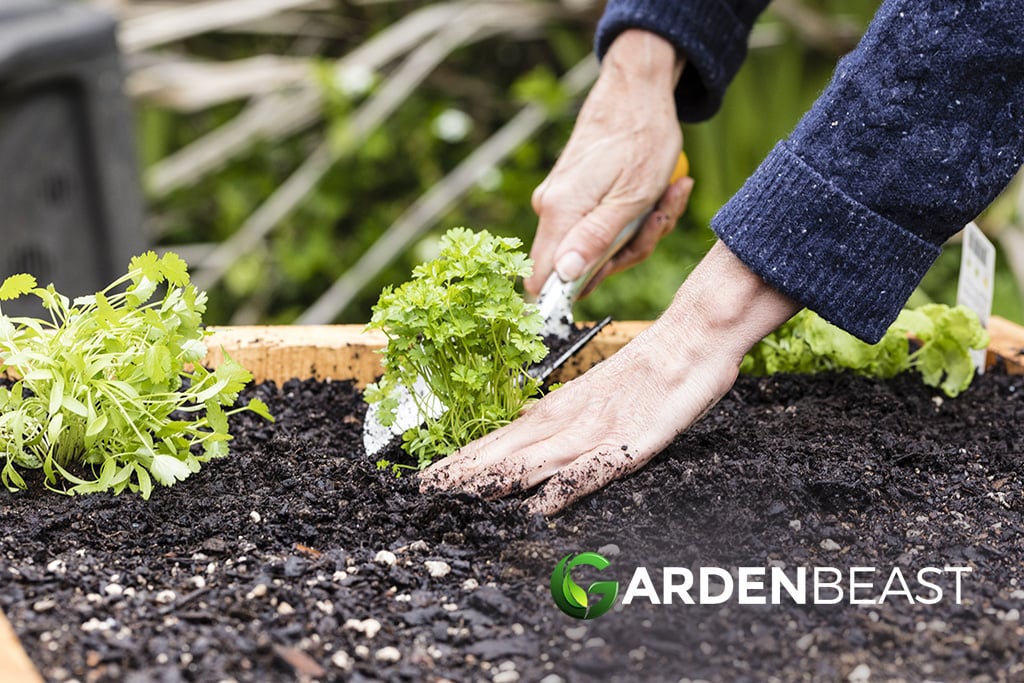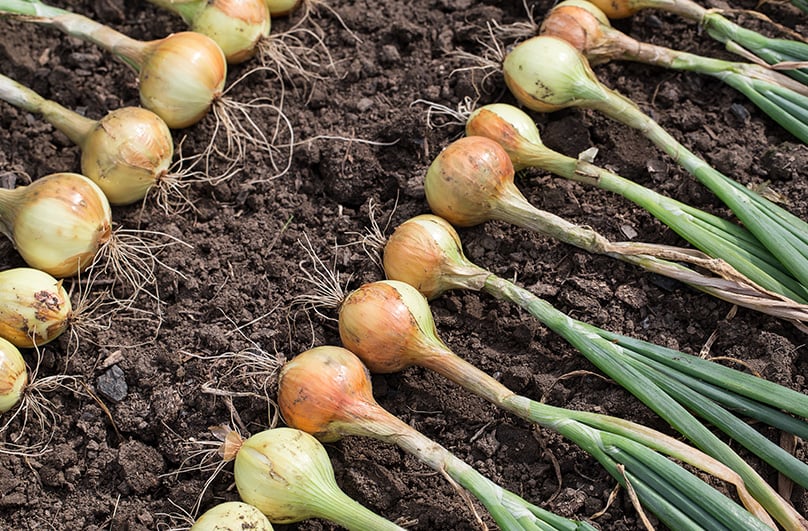Growing onions isn’t as challenging as you think. Onions are a hardy vegetable, and they grow well in cold weather conditions. Adding some onions to your roasted vegetable dish adds a new flavor dimension to the dish, and they taste even better when they’re from your garden.
Onions suit planting directly to your beds, or you can use raised beds for a bountiful crop.
Growing in raised beds increases airflow to the roots, increase your yield. There are plenty of varieties of onions suitable for growing in your garden.
In the southern states, it’s best to plant most onion varieties in the fall. We always recommend that gardeners use onion sets, as these offer the best success rates, and you don’t have to worry about frost killing your onions.
We recommend sets, but it’s possible to grow your onions from seeds as well. Raise some spring onions to add to a fresh garden salad or red Weatherfield’s for roasting. We put together this guide to give you everything you need to know about growing onions this coming season.

Tips for Planting Onions
We recommend that you plant your onions in the ground as soon as the last frosts fall. Check your local listings for the final frost dates, and then wait two weeks before planting your onions.
Before the winter sets in, you need to prepare your beds for the following growing season. Make sure you till the soil and turn in some compost to the beds. Leave them to rest over the winter, and you’ll have a fertile bed that’s ready for planting in the early springtime.
Two weeks before you plant, turn the soil to loosen the ground. This technique improves the drainage of the soil while allowing for optimal aeration. As soon as you can work the ground, get planting.
- Vigorous and Adaptable - Yellow Sweet Spanish Onion seeds mature into sturdy biennial plants with abundant yields. Known for their adaptability, these onions are ideal for both container and ground gardens. They are a top choice for those seeking high yields from a resilient and reliable onion variety.
- Culinary Delight - Yellow Sweet Spanish Onions are recognized for their sweet, mild flavor, making them a very versatile veg to grow. These onions are traditionally used in a variety of dishes ranging from salads to hearty roasts, adding a delightfully sweet note to your home-cooked meals.
- Sustainable Living - Growing your own Yellow Sweet Spanish Onions is a step towards a sustainable, self-sufficient lifestyle. Homegrown sweet onions are a delight whether eaten fresh, chopped and frozen or dried for long term food supplies.
- The Info You Need to Grow - The seeds are packed in a beautiful paper packet with instructions for successful and easy growing in your home garden. Each package includes tips for saving seeds after harvest.
- Small American Family-Owned Business - We’re committed to providing fresh, high-quality sweet onion seeds for you to plant now or store for future growing seasons. Our non-GMO, open-pollinated seeds ensure top germination rates.
- Versatile Collection - Start your seeds in fall or spring and plant your seedlings outdoors to enjoy a summer crop of delicious onion bulbs. This set of onions is appropriate for container gardens and raised beds. It can be grown outdoors in full sun or indoors with sufficient light.
- Four Reliable Cultivars - Ideal for those living in Zone 5 or 6, this unique collection of onions includes a mix of long day, short day, and intermediate day onions. All onions can be grown outside these zones, but may not grow to full size. These popular heirlooms include Red Burgundy, White Grano, Walla Walla (yellow), and Tokyo Long White Bunching Onion (green onion).
- Sustainable Living - Vegetable gardening is an essential foundation of a more self-sufficient lifestyle. Home grown fruits and vegetables are generally more flavorful and nutritious than store-bought. This mix of onion varieties will provide you with plenty of tasty produce for using fresh and storing long-term.
- The Info You Need to Grow - The Onion seeds for planting are packed in a beautiful paper packet with instructions for successful growing and germination in your home garden. Instructions for saving seeds after harvest are included. Getting started is simple for both beginner and experienced gardeners.
- Small American Family-Owned Business - We’re committed to providing fresh, high-quality Onion seeds for planting now or storing for future seasons. We sell only safe, non-hybrid non-GMO heirloom seeds that are open-pollinated, untreated, and tested for the best germination rates. They remain viable for years if stored cool and dry.
- Gardening Kit: 8 Unique Onion Seeds Variety Pack NON GMO Heirloom Seeds LESS THAN $0.70 PER SEED VARIETY PACK 2,200+ seeds including: Onion Eclipse L303, Onion Red Burgundy, Onion Tokyo Long White Scallion, Onion Violet de Galmi, Onion Walla Walla, Onion White Grano PRR, Onion White Sweet Spanish, Onion Yellow Sweet Spanish.
- Enhanced Gardening Experience: Our seeds for planting outdoor and indoor garden come in a waterproof resealable bag with 8 individual craft seed packets inside. Enjoy planting home garden with mini gardening supplies including leaf clipper, tweezers, seed dibber tool, weeding fork, and widger tool. Scan the QR codes on the seed packets to access online gardener basic growing guide and culinary book. Learn about vegetable gardening, discover everyday recipes to make the most of your harvest.
- Garden Success Assured: Whether you have an indoor hydroponic garden or an outdoor onion patch, our seeds are perfect for any setting. With a superior germination rate proven through various tests, enjoy fresh vegetables growing food all year round. Enjoy the satisfaction of growing seeds on your own garden, knowing that our high-quality seeds for planting vegetables guarantee abundant harvest and delicious meals for you and your family.
- Perfect Survival Seeds Garden Gift: Our garden starter kit makes an ideal gift for couples, vegetarians, vegans, gardeners, and anyone looking for a new hobby. Whether it's a housewarming, party, birthday, anniversary, or any occasion, surprise your loved ones with the joy of gardening and the promise of fresh, homegrown plant food.
- Quality You Can Trust: Proudly made in the USA by a Small Family-Owned Business, our seeds for planting onions undergo rigorous testing with a 90%+ germination rate. Sealed to last for up to 2 years, you can trust the freshness and viability of our garden seeds.
Last update on 2024-10-02 / Affiliate links / Images from Amazon Product Advertising API
In most cases, you’ll be planting around late March or early April, as long as the temperature doesn’t drop below 20°F. Select a planting site in your garden that gets full sunlight for at least 6 to 10-hours every day. It’s best to select a location that gets shade in the afternoon.
Onions like growing in soil that’s high in nitrogen, and make sure that the earth is loose and loamy. Compacting the soil affects growth, and you’ll end up with under-sized onions. Onion plants require nourishment throughout the growing season to develop healthy harvests.
Onion seeds don’t last long, so you’ll need to plant fresh seeds each year. If you decide to start your seeds indoors early, then we recommend you begin at around 6-weeks before your planting date. Gardeners should think of onions as a leaf crop, instead of a root crop, and follow growing guidelines accordingly.
- IMPROVE ONION PLANT HEALTH AND QUALITY
- PROVIDES THE NECESSARY AMOUNT OF MACRONUTRIENTS AND MICRONUTRIENTS TO ACCELERATE PLANT GROWTH
- CONTAINS NITROGEN, PHOSPHORUS, POTASSIUM, CALCIUM, MAGNESIUM, SULFUR, BORON, COPPER, MANGANESE, AND ZINC
Last update on 2024-10-02 / Affiliate links / Images from Amazon Product Advertising API
As a result, you’ll plant your onion sets 1-inch below the surface of the spoil. For transplants or onion sets, space your plants at least 4 to 5-inches apart and in rows spaced 18-inches apart. We always recommend that gardeners practice crop rotation when growing onions. As mentioned, onions are heavy feeders, and they deplete soil nutrients quickly.

How to Plant a Sprouted Onion
It might surprise you to learn that you can plant sprouted onions. However, it’s important to note that you won’t get as many onions as you would when you start from seed. Planting sprouted onions produce plenty of tasty green leaf sprouts, and it’s easy to grow and care for the onions in a container garden.
Fill a 5-gallon pot with fresh potting soil. Add some vermiculite and perlite, along with a dose of nitrogen fertilizer. A week later, place the onion in the center of the pot and plant the sprouted onion around 1-inch below the surface of the soil.
Water your onion, and leave the pot in a sunny area of your yard or on the balcony of your apartment. Harvest the green sprouts as they appear, and add them to your recipes. If your onion produces a shoot that turns into a flower, wait for the flower to mature in the spring, and harvest the seeds for next season.

Tips for Caring for Your Onions
When you’re growing onions, you need to accommodate this vegetable’s need for nutrients throughout the growing season. Onions require the addition of fertilizer to the beds every few weeks to increase bulb size and provide you with the best harvest.
Stop fertilizing your onions as the onions start to push the soil away and form bulbs. It’s important not to cover the bulbs with soil, or push them back under the surface. The bulbs need exposure during the final maturation stage.
If you mulch your garden every few weeks, then you can get away with watering your onions once or twice a week, even in hot weather conditions. The more you water your onions, the sweeter the taste. However, make sure that the soil is draining well, as waterlogged bulbs will end up rotting and attract disease to your crop.

Pests and Diseases Affecting Your Onions
There are a few pests and diseases you need to watch out for when growing onions.
Thrips
These tiny insects are about the size of a pinhead on a sewing needle. It’s tough to identify Thrips with the naked eye. The best way to test for the presence of this pest in your onion garden is with the paper shake method.
Take a sheet of black of dark-colored paper with you to the garden. Shake the tops of the onions onto the paper. If you notice any small tanned-bodies falling onto the paper, then your onions are dealing with a thrip infestation.
Mix up some insecticidal soap, and spray it over your garden. The thrip should die with two to three treatments. Spray the plants three days apart, and complete your paper test the following week to see if there are any survivors you need to get rid of in your onion garden.
Onion Maggots
These pests also present a threat to the success of your onion harvest. Cover the onion crop with a fine-mesh net. Seal the entrance to the garden by placing soil around the edges of the netting.
Onions maggots like to lay eggs at the base of your onion plants. The netting will prevent them from gaining access to your onion crop. Keep the mulch away from around your green shoots, as it might attract insects to the new growth.
Typically, onion maggots are only an issue for gardeners that deal with extended rainy periods during the summer. If you live in a dry region of the United States, you might not encounter this pest.
Tips for Harvesting Your Onions
Make sure that you pull out any onions that start to develop flower stalks. When the flowers start appearing, it means that your onions stop growing.
If you do get flowers shooting from your onions, harvest them immediately, and use them in cooking with in the next few days. These flowered onions will not store well, and you might have to throw them away if you don’t manage to use them in time.
As your onions start to mature, the tops of the green shoots begin to turn yellow. The sprouts will fall over, and at that point, you can bend the stalks at the base to speed the ripening process. A few days before the harvest, loosen the soil around the garden, as this strategy helps to promote drying.

- When the tops of the onions eventually turn brown, it’s time to pull them from the ground or container. Harvest your onions ion the following summer before the onset of colder weather in the fall. The fall weather might spoil your onion crop.
- Clip your onions roots back, and cut the tops to one-inch in length. You can leave the heads on the onions if you’re planning to braid them. Leave your onions to dry and cure on the ground before storing.
- Make sure you’re careful when handling your onions. Light bruising can cause the onset of rot, which spreads to the other onions in your root cellar. Store your onions at temperatures of between 40 to 50°F.
- You can store them in a drawer in a root cellar or braids. Your onions prefer a cool and dry place for optimal storage conditions, aiming the root cellar the ideal storage option for your onion crop.
Recommended Onion Varieties
When selecting your onions for your garden, you have the option of choosing two varieties.
Long-day varieties are better for regions of the United States that have cold weather. Short-day types suit warmer areas of the U.S.
Long-day Onion Varieties
- Yellow Sweet Spanish – round in shape and large, white to yellow.
- First Edition – high-yields, plenty of intense flavor, and creamy-colored in appearance.
- Red Wethersfield – Red-skinned with white flesh. This variety stores well.
Short-day Onion Varieties
- Stuttgarter – Typically sold in onion sets, this variety has early maturation, with a flat shape and yellow color.
- White Bermuda – White in color, with flat, thick bulbs. These onions have a mild taste.
- Burgundy – The best table onions, with a sweet-tasting white flesh and red skin.




